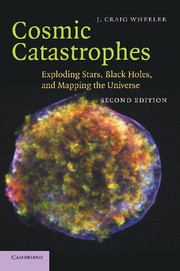Book contents
- Frontmatter
- Contents
- Preface
- 1 Setting the stage: star formation and hydrogen burning in single stars
- 2 Stellar death: the inexorable grip of gravity
- 3 Dancing with stars: binary stellar evolution
- 4 Accretion disks: flat stars
- 5 White dwarfs: quantum dots
- 6 Supernovae: stellar catastrophes
- 7 Supernova 1987A: lessons and enigmas
- 8 Neutron stars: atoms with attitude
- 9 Black holes in theory: into the abyss
- 10 Black holes in fact: exploring the reality
- 11 Gamma-ray bursts, black holes and the Universe: long, long ago and far, far away
- 12 Supernovae and the Universe
- 13 Wormholes and time machines: tunnels in space and time
- 14 Beyond: the frontiers
- Index
5 - White dwarfs: quantum dots
Published online by Cambridge University Press: 14 September 2009
- Frontmatter
- Contents
- Preface
- 1 Setting the stage: star formation and hydrogen burning in single stars
- 2 Stellar death: the inexorable grip of gravity
- 3 Dancing with stars: binary stellar evolution
- 4 Accretion disks: flat stars
- 5 White dwarfs: quantum dots
- 6 Supernovae: stellar catastrophes
- 7 Supernova 1987A: lessons and enigmas
- 8 Neutron stars: atoms with attitude
- 9 Black holes in theory: into the abyss
- 10 Black holes in fact: exploring the reality
- 11 Gamma-ray bursts, black holes and the Universe: long, long ago and far, far away
- 12 Supernovae and the Universe
- 13 Wormholes and time machines: tunnels in space and time
- 14 Beyond: the frontiers
- Index
Summary
SINGLE WHITE DWARFS
White dwarfs are certainly the most common stellar “corpses” in the Galaxy. There may be more white dwarfs than all the other stars combined. The reason is that low-mass stars are born more frequently, and low-mass stars create white dwarfs. In addition, after a white dwarf forms, it sticks around, slowly cooling off, supported by the quantum pressure of its electrons. This means that the vast majority of the white dwarfs ever created in the Galaxy are still there. The exceptions are a few that explode or collapse because of the presence of a binary companion. There are probably ten billion and maybe a hundred billion white dwarfs in the Galaxy. Most white dwarfs have a mass very nearly 0.6 times the mass of the Sun. A few have smaller mass, and a few have larger mass. Exactly why the distribution of the masses is this way is not totally understood.
White dwarfs provide clues to the evolution of the stars that gave them birth. To fully reveal the story, astronomers need to probe the insides of the white dwarf. Ed Nather and Don Winget at the University of Texas invented a very effective technique to do this. The technique uses the seismology of the white dwarfs to reveal their interior structure, just as geologists use earthquakes to probe the inner Earth. Under special circumstances, depending on their temperature, white dwarfs naturally oscillate in response to the flow of radiation from their insides.
- Type
- Chapter
- Information
- Cosmic CatastrophesExploding Stars, Black Holes, and Mapping the Universe, pp. 68 - 78Publisher: Cambridge University PressPrint publication year: 2007



